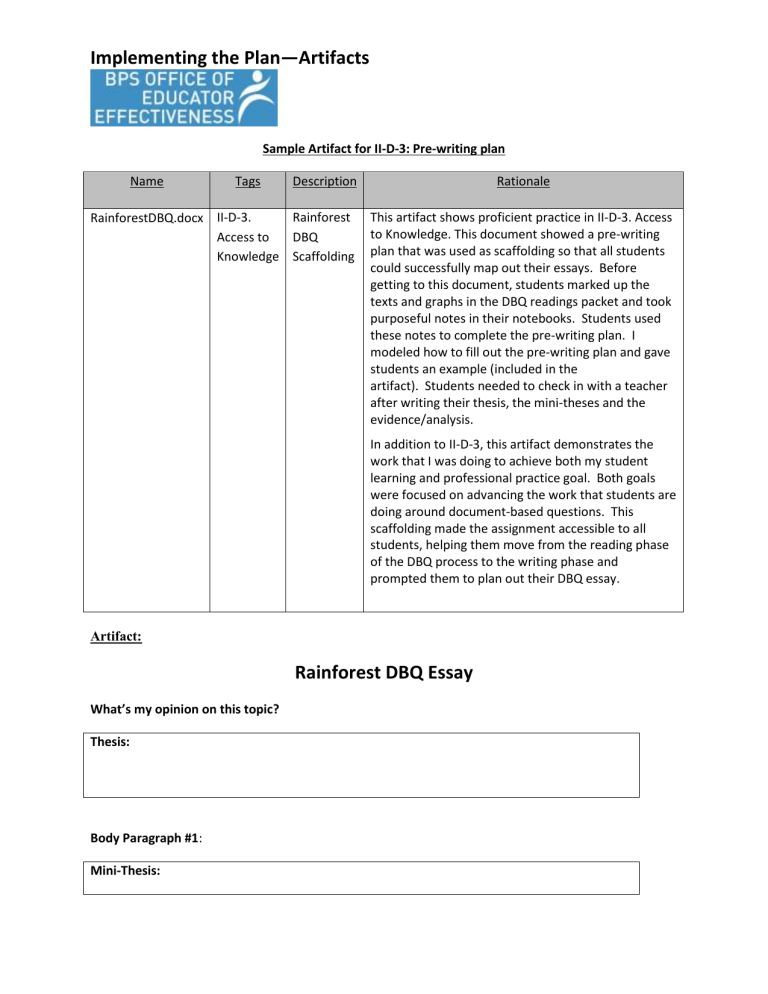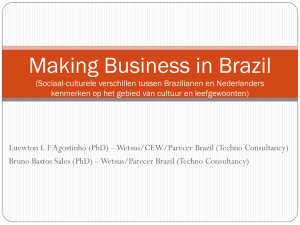View a sample artifact for II-D

Implementing the Plan—Artifacts
Name Tags
Sample Artifact for II-D-3: Pre-writing plan
Description Rationale
RainforestDBQ.docx II-D-3.
Access to
Knowledge
Rainforest
DBQ
Scaffolding
This artifact shows proficient practice in II-D-3. Access to Knowledge. This document showed a pre-writing plan that was used as scaffolding so that all students could successfully map out their essays. Before getting to this document, students marked up the texts and graphs in the DBQ readings packet and took purposeful notes in their notebooks. Students used these notes to complete the pre-writing plan. I modeled how to fill out the pre-writing plan and gave students an example (included in the artifact). Students needed to check in with a teacher after writing their thesis, the mini-theses and the evidence/analysis.
In addition to II-D-3, this artifact demonstrates the work that I was doing to achieve both my student learning and professional practice goal. Both goals were focused on advancing the work that students are doing around document-based questions. This scaffolding made the assignment accessible to all students, helping them move from the reading phase of the DBQ process to the writing phase and prompted them to plan out their DBQ essay.
Artifact:
Rainforest DBQ Essay
What’s my opinion on this topic?
Thesis:
Body Paragraph #1:
Mini-Thesis:
Implementing the Plan—Artifacts
Evidence #1:
Document(s):
Evidence #2:
Document(s):
Body Paragraph #2:
Mini-Thesis:
Evidence #1:
Explanation/Analysis:
Explanation/Analysis:
Explanation/Analysis:
Implementing the Plan—Artifacts
Document(s):
Evidence #2:
Document(s):
Explanation/Analysis:
Model Essay Body Paragraph
The cattle ranchers help Brazil’s economy to be the best it can be. First of all, cattle ranchers
are among the biggest exporters in Brazil (Document A). They export beef and leather throughout the entire world, which makes money for the people of Brazil. The business of exporting beef and leather from Brazil to other countries also provides a lot of jobs for the people in Brazil. Some people work on the ranches, others work on making the products like leather wallets or shoes, and others work on packaging them and transporting them throughout South America and the rest of the world. Without
Implementing the Plan—Artifacts
the exports that come from cattle ranching, there would be far fewer jobs in Brazil, far less money made
and the economy would not be as good. In addition, because beef and leather exports have helped
Brazil’s economy, the poverty rates have fallen a lot in the last twenty years (Document F). In fact, the poverty rate used to be about 45 percent in Brazil in 1991, which means that 45 out of every 100 people were extremely poor. Twenty years later, the poverty rate had fallen to about 25 percent. For every 100 people in Brazil, there are twenty fewer people living in poverty now. As the poverty rate drops, more people in Brazil have a better chance at living a good life, and their standard of living has improved.
Without the money and jobs that cattle ranching has generated, the poverty rate would never have gone
down so much.
Underlined = Mini-Thesis
Bold = Evidence statements
Italic = Explanation and analysis
MODEL PLAN
What’s my opinion on this topic?
Thesis: Cattle Ranchers need to keep working in the rainforest, because they are helping Brazil’s economy in a big way and providing important products to the entire world.
Body Paragraph #1:
Mini-Thesis: The cattle ranchers help Brazil’s economy to be the best it can be.
Evidence #1: Brazil are among the biggest exporters in Explanation/Analysis: the world.
Implementing the Plan—Artifacts
(Document A)
Evidence #2: The poverty rates are falling in Brazil over the last twenty years.
(Document F)
export beef and leather everywhere
makes money for people in Brazil
creates jobs for people in Brazil
the economy would not be as good with the exporting business from cattle ranching
Explanation/Analysis:
poverty rate used to 45% in 1991 and about
25% in 2009
more people in Brazil have a good standard of living now
the jobs and $ provided by cattle ranching has helped to lower the poverty rate








